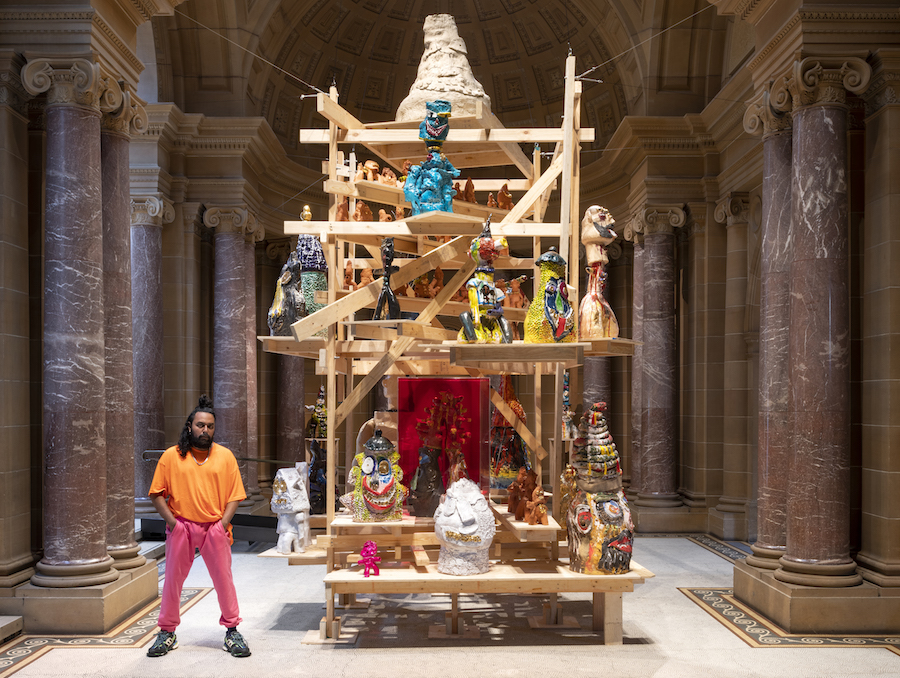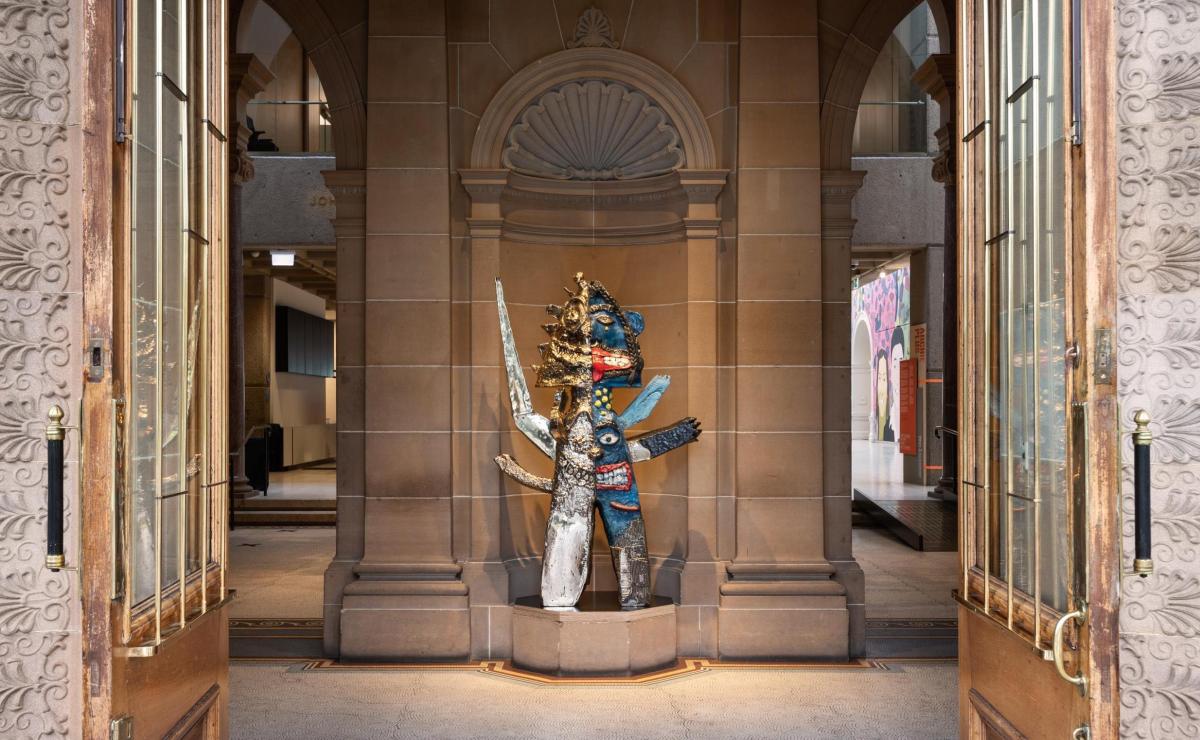2020 ignited a re-imagination of the creative industries through a singular shared conundrum: what does it mean to make and engage with art when the physical doors are closed?
For the Head Curator of International Art at Art Gallery of NSW (AGNSW), Justin Paton, this was the ultimate challenge.
‘Something extraordinary happened for the second time in the Gallery’s 149-year history – it was closed for almost 3 months. It’s been an amazing acid test for the museum. The building is there, the name is there and the art is there inside the walls, but the people are nowhere to be seen,’ Paton said.
For Paton, the restrictions on engaging international artists inspired Archie Plus, a physical extension of the Gallery’s rapid response digital project, Together in Art. Lead by Paton, the curatorial team at AGNSW have put together an exciting program of free events to enjoy over summer.
‘In a year of challenge, change and loss, we wanted to underline the fact that a public art museum is a place where people can come and encounter imaginative work, and take that opportunity to reflect on the year. We wanted to affirm art’s position in that: a place for solace during this unprecedented time.’
A bold take on portraiture
Inspired by the portraiture premise of the Archibald Prize, one of the major ticketed events of the summer, Archie Plus amplifies this concept through alternative and exciting responses to the idea of portraits, exploring notions of people power and community.
‘Humans love to look at images of other humans. When we encounter a portrait of someone interesting to us, different from us or similar to us – it unlocks something deep within us.’
Paton describes the works commissioned through Archie Plus as a polyphonic experience, where visual language intersects with auditory stimulation. All of the works were created within or as a response to the Gallery’s physical space.
Two of these works include Gold frames, gold chains, a digital music work by Western / South-Western Sydney hip-hop artists Nadean and L-Fresh the Lion, and large-scale collaborative mural Love owls and mermaids singing in the rainbow pop by artist collective Studio A.
Gold frames, gold chains was composed in-situ as part of the Archie Plus residency process, evolving into a two-channel video installation that uses rap techniques of anadiplosis (the word ending one verse is used to start the subsequent verse) to simulate a live rap cypher (freestyle performance). The new work was an opportunity for the artists to tell their story their way.
Love owls and mermaids singing in the rainbow pop was painted across two weeks by seven artists from Studio A, a collective of artists with intellectual disability, on the largest single wall in the Art Gallery of NSW. The work provides an optimistic vision of care and personal connection, featuring portraits of people, animals and imaginary companions (think flying mermaid).

Ramesh Mario Nithiyendran with his installation for Archie Plus at AGNSW, 2020. Photo Mark Pokorny.
The tactile art of making in a socially distanced world
In the entrance vestibule of the Gallery sits a newly commissioned 77-piece installation work Avatar Towers by Sri Lankan-born, Western Sydney-based sculptor Ramesh Mario Nithiyendran, gregariously welcoming visitors into the newly re-opened space.
‘What’s great about Archie Plus is that it mobilises the energy of the Archibald to engage audiences. Even my parents know what the Archibald is, and they only visit galleries when I’m showing in them!’ says Nithiyendran.
The work explores the ideas of avatars within a religious framework, as a physical manifestation of something divine, but is also a deadpan reference to avatars prevalent in global digital culture, such as emojis. The prestige of exhibiting at this premier institution is not lost on Nithiyendran.
‘My international family Whatsapp group was going off when I told them I was exhibiting at the Art Gallery of NSW. I’ve officially acquired the title of the ‘cool relative’, joked Nithiyendran.
This year, we spent so much time on digital devices that there is something grounding and uplifting to see someone make something from beginning to end.
Justin Paton, AGNSW
‘This is the most significant installation I have presented in NSW and one of the largest I’ve produced in a long time. I’ve presented a lot of large-scale works internationally, but it felt quite important that this was in my hometown. It’s a really ambitious work and a career defining moment to be exhibited at the Gallery.’
Paton also gushed that working with Ramesh on this large-scale installation for the Gallery entry has been a career highlight. As part of the commissioning process Paton visited Nithiyendran at his artistic residence at Parramatta Studios, where they discovered their mutual appreciation for the tactile elements of art making.
‘The energy of the hand-made is interesting,’ said Paton.
‘This year, we spent so much time on digital devices that there is something grounding and uplifting to see someone make something from beginning to end, at a time when we are feeling distant from each other and the physical world,’ continued Paton.
Every component of Nithiyendran’s installation is a deliberate response to the formal and symmetrical architecture of the inside of the gallery – the vibrant grunge aesthetic of the statues creating an interesting contrast. Even the wooden structure on which the idols are placed were inspired by scaffolding Nithiyendran had seen at the Dhaka Art Summit in Bangladesh.
History repeats in interesting new ways
The creative development process for Nithiyendran also involved extensive research into the Gallery’s South Asian art collection, two pieces of which have been placed adjacently to his own work: a Gandhāran Buddha statue and a Javanese Ganesha figure.
‘There is something powerful about being featured alongside work with thousands of years of history’, said Nithiyendran.
‘With South Asian sculptures, there is so much movement, imagination and plurality, and the compositions are very joyous. Through my work with ceramics, I feel connected to this history of making cultures. It’s very powerful.’
For Paton, the placement of the Gallery’s collections alongside the newly commissioned contemporary works from Archie Plus was deliberate.
‘It’s not a forced choice between the old and new, or historical and contemporary, it’s about both co-existing and making the space feel alive,’ he said.
‘It’s wonderful seeing people back in the building, hearing artists, writers and performers talk about what they are making, and witnessing first-hand how the works are igniting discussion on the year that has been.’
Will Archie Plus shift the way Paton curates in the future?
‘Working within the same time zone has been an interesting shift. Archie Plus has opened my eyes to what artists are up to in Sydney and I couldn’t imagine curating without connecting profoundly with the local [artist community]. The international artists we work with are interested in the human and environmental stories that have unfolded here on Gadigal land, including the conflict and cultural exchange that have shaped this place. The future does look local in many ways.’
Archie Plus is on at Art Gallery of NSW until 21 February 2021.





